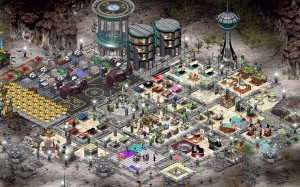
The game Space Colony allows players to develop a colony on a distant planet. It appears that such a fantasy may soon become reality.
Over the course of my life, I’ve had the privilege to travel across the world and see lots of fascinating places. But there’s one place that I haven’t been to: the Moon. However, it looks like there could be a chance to travel to the Moon in the near future: Russia has just announced their plan to put a manned colony on the Moon by 2030, and is currently racing to dispatch the first robotic rovers to explore the lunar surface in two years.
Russia has had a long fascination with space exploration; back in 1924, a Soviet film studio released a silent film called “Aelita”, about a young man who travels to Mars in a rocket ship and leads a popular uprising against the planet’s tyrannical oligarchy. While not a terribly well-known film, it had a lasting influence on science fiction. More famously, the Soviet Union and America were engaged in a “space race” with each other to try and be the first to get into space (the matter of who won the space race is still a hotly debated topic; while the Soviets were the first to put a man in space, the Americans were the first to put a man on the Moon). Even today, Russia has several stations in outer space.
Yesterday, however, the Russian newspaper Izvestia claimed it had gained access to a draft government program that outlines a three-step plan toward manning the Moon. A robotic craft would be sent to the Moon in around 2016 and through the next decade, and Russia would be ready to send manned missions to orbit the Earth’s satellite by 2028. In the final stage of the expedition, planned for 2030, humans would be sent to the lunar surface to set up the infrastructure for an initial colony using local resources. The program also plans to build a space-and-Earth-monitoring observatory on the Moon.
The document underlined the need for speedy lunar exploration, since they fear that leading space powers will expand and establish their rights to “convenient lunar footholds” if they don’t get there first. It’s not entirely clear how much the mission will cost, but the first stage alone is estimated to cost around 28.5 billion rubles (roughly $815.8 million), while developing and building a piloted spaceship would add 160 billion rubles or so to the project. Therefore, Russia intends to attract private investors to help bankroll the project. While the program intends for there to be international cooperation on the project, it must ultimately retain its national (Russian) identity. According to NASA, it’s possible that lunar resources could produce a treasure trove of rare and valuable minerals that could be strategically important, although the concentration and distribution of these elements is still unclear. The Moon could also be used as a launchpad for future missions into deep space.
However, Russia isn’t the only country with their eye on lunar exploration; China, India and Japan are also developing lunar exploration projects, and a California-based company called Moon Express is planning to send its first robotic spacecraft to the satellite next year.